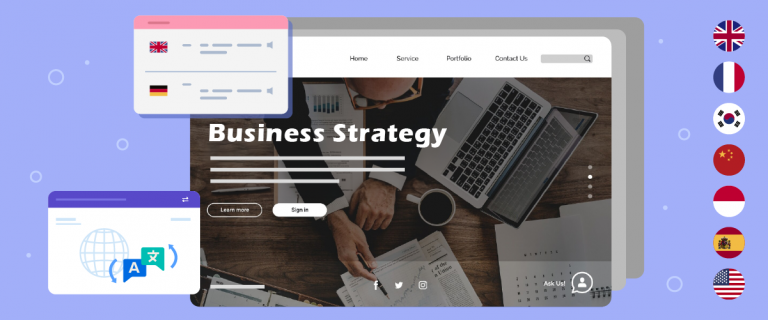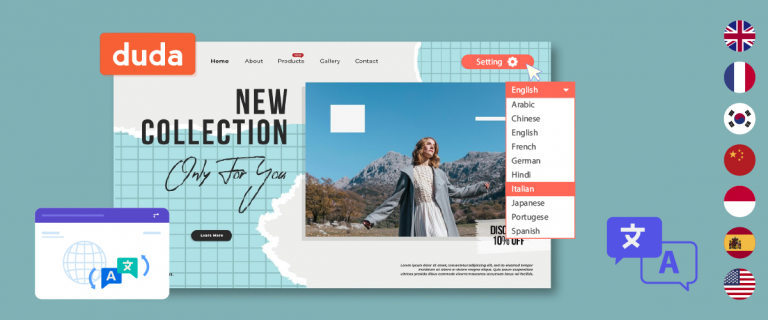Businesses must expand their reach beyond domestic borders to remain competitive in the global market. A study by Common Sense Advisory found that 72.4% of consumers are inclined to buy a product if it is presented in their language, and 56.2% prioritize access to information in their language over price.
Optimizing your website and content for different countries and languages increases your visibility, boosts organic traffic, and improves conversions. Research shows that localized content can result in a 100% increase in engagement and a 67% increase in conversions. This article will emphasize the significance of international SEO for businesses seeking to expand their global reach with data-supported insights. Let’s delve into a step-by-step guide to creating a successful international SEO strategy to help you achieve your objectives.
What is international SEO?
International SEO is a multilingual marketing strategy that optimizes your website to target users from different countries, expanding its reach and visibility in search results across different languages and regions. To execute an effective international SEO strategy, it is important to conduct thorough market research data to determine the language preferences, local search engine market share, and user behavior in each target region. This information can help you tailor your website’s content, keywords, and technical aspects to increase its visibility and drive conversions.
Optimizing your website for international SEO requires more than just translating your content into multiple languages. You need to consider cultural differences, regional nuances, and even political sensitivities when creating content for each target region. Moreover, optimizing technical elements such as domain name structure, hreflang tags, geotargeting settings, and mobile-friendliness can greatly enhance your website’s visibility in local search results.
The importance of international SEO for global business reach
Expanding your business globally requires a solid online presence, and international SEO is crucial. By targeting specific countries with the most spoken languages and relevant keywords, you can increase your brand visibility globally. This means more potential customers discover your website in different regions.
Additionally, international SEO allows you to tap into new markets, expanding your customer base and driving conversions. With the right strategy, you can optimize your website for specific countries, attracting local users and tailoring your content to suit their language and regional preferences.
Increased brand visibility on a global scale
One of the main benefits of international SEO is increased brand visibility on a global scale. Targeting specific countries with relevant keywords can improve your website’s visibility in global search results and attract users from different regions.
Optimizing your website’s content and navigation menu for international users is essential to achieve this. This includes translating your content into different languages, adding language switchers, and adapting your website to suit local culture and regional preferences.
By implementing international SEO best practices, you can boost your online presence and increase your website’s visibility in different countries, capturing the attention of potential customers worldwide.
Expanded customer base
Another advantage of international SEO is expanding your customer base. Targeting specific countries can attract local users and tailor your website’s content to their language, preferences, and cultural nuances. International SEO allows you to tap into new markets and reach potential customers in different countries. By optimizing your website for specific target markets, you can attract users who are actively looking for products or services you offer.
When targeting different countries, it’s essential to consider the specific needs of your target audience. Conducting market research and competitor analysis will help you understand user behavior, preferences, and search patterns in each target market. This will allow you to create relevant content that resonates with your target audience, increasing your chances of capturing their attention and driving conversions.
Boosting organic traffic and conversions
Targeting relevant keywords for an international audience boosts organic traffic and conversions. The starting point is to enhance user experience and website visibility through local language targeting. By focusing on specific country markets and optimizing website content, a single domain can appeal to diverse audiences. Leveraging international SEO best practices increases visibility in different countries and resonates with Spanish speakers or other non-English official languages. This approach ensures that each piece of content aligns with users’ search intent in the United States and elsewhere, driving higher organic traffic and conversions.
How do you build an international SEO strategy for going global organically?
Conducting thorough keyword research in the target countries and languages is crucial to develop a successful international SEO strategy. After determining the appropriate keywords, optimize your website’s content and structure to cater to different languages and regions. It is also essential to create localized content and use hreflang tags to indicate language and country targeting. Finally, focus on building high-quality backlinks from relevant international websites. For more details on how to create your own international SEO strategy, let’s check the detailed guide below.
Setting clear international SEO goals
For businesses planning international SEO efforts, setting specific objectives is vital to the success of their campaign. Defining measurable targets for website visibility in target regions is crucial for tracking progress and optimizing strategies. It’s also important to align international expansion goals with overall user experience to ensure a seamless online journey for users in different regions.
By establishing clear international SEO goals, businesses can effectively reach their target audience in their preferred languages while starting from a single domain. This can help improve website visibility, attract more traffic, and ultimately drive conversions. In addition to language considerations, it’s essential to account for cultural differences when expanding into new markets. By doing so, businesses can tailor their content and marketing strategies to meet the needs and preferences of their target audience.
To achieve these objectives, businesses must conduct comprehensive research on the local market, search trends, and audience behavior. Google Keyword Planner, Google Trends, and Google Search Console are useful tools for this purpose.
Market and competitor analysis
When conducting international SEO, it’s crucial to research the search engine market share in each target region to understand which search engines dominate specific areas. You can use tools such as SEMrush, Ahrefs, or Moz that can provide valuable insights into competitors in particular countries and the effective strategies in those regions. Market research helps identify potential customers in different regions, enabling the creation of targeted content tailored to the needs and preferences of diverse audiences. Understanding each region’s target and official language is the starting point for optimizing content for international SEO. Ensuring that all international versions are on a single domain is essential, making it easier for search engines to index and rank them.
Try the top languages spoken in the worldwide market
When expanding your business to different global markets, it is essential to consider the most languages spoken. To create a truly international SEO strategy, start by identifying relevant keywords in the target language. For instance, Mandarin Chinese is the most spoken language globally, so it’s important to consider incorporating keywords in Mandarin Chinese if you’re targeting a Chinese-speaking audience. Additionally, it is important to research the official and dominant languages spoken in each region to reach the target audience effectively. Adapting website content to suit the most relevant version for different regions ensures that it will connect with the local audience and appear in searches conducted in the target language. By taking this approach and using a single domain for all international versions.
Conducting keyword research for target markets
When conducting keyword research for target markets, it’s essential to analyze search volume and organic traffic specific to the target countries. Consider adding long-tail keywords that are specific to each country or region. Additionally, using tools such as Google Keyword Planner or SEMrush can help you identify popular search terms and competition in your target countries.
You can optimize your website localization strategy for different regions by targeting country-specific search terms and including relevant keywords for your international audience. Prioritizing these keywords is a crucial starting point for successful global SEO. Ensuring your content aligns with your international audience’s target and official language can significantly impact its visibility and engagement. Additionally, utilizing a single domain for your international SEO efforts can streamline your strategy and enhance user experience.
Focusing on language or specific countries
When it comes to targeting different languages on your website, you may face the question of using dedicated URLs or hreflang tags. While hreflang tags can be a good solution for a global approach to language targeting, it’s essential to carefully consider your target market and decide whether country targeting or language targeting is more appropriate for your website.
To make an informed decision, you may want to research your target audience’s language preferences and online behaviors. This can help you determine whether language or country targeting will more effectively reach your desired audience. Once you have decided, you can simplify the process of implementing language targeting by using a plugin like Linguise. By automatically translating your website, Linguise can help ensure that your content is automatically accessible to a wider audience, making it easier for them to engage with your website in their native language.
Having a navigation menu and language switcher
Improving the user experience for international audiences is crucial for international SEO. To achieve this, it is important to have a navigation menu tailored to the target audience’s official language. Adding a language switcher can also greatly improve the user experience, allowing visitors to navigate the website seamlessly in their preferred language.
With automatic translation plugins, Linguise, adding a language switcher to your website is now easier than ever. It not only helps you add a language switcher with various design options, but it can also assist in translating your website content to the target language, further optimizing the user experience for your audience.
Modifying content to align with local culture and regional preferences
To cater to the local audience in different countries, it is essential to tailor website content delivery networks to suit their specific region’s target and official language. By customizing website content, you can ensure that it resonates with the cultural nuances and preferences of native speakers. Adapting website content for a single-domain approach can also significantly enhance its visibility.
Adapting content to suit local culture and regional preferences is crucial for businesses that operate in multiple countries or regions. It involves understanding the target audience’s language, customs, and preferences and tailoring your content accordingly. This can include translating web pages to modifying images and graphics to better align with the local culture.
Customizing content and localize website design can help attract local audiences by making them feel more connected to your brand. It shows that you understand their needs and will go the extra mile to meet them. Additionally, adapting your website for a single-domain approach can greatly improve its visibility on search engines like Google by consolidating all traffic onto one domain.
Make sure the translation quality
When optimizing content for international audiences, ensuring that the translation quality is of the highest standard is crucial. The target language must accurately represent the original content and resonate with the official language of the audience. The starting point should be to evaluate the translation tools to guarantee high-quality output thoroughly.
Using the best automatic translation plugin with high-quality translation capabilities is essential. Investing in translation quality is essentially an investment in optimizing the content marketing strategy for the target audience. It ensures that each content resonates with the intended audience, positively impacting search results and enhancing the user experience.
Building local links to boost SEO
To enhance the visibility of a website in specific countries, it is essential to develop local links. For example, if you have a website that sells handmade jewelry and you want to target customers in Japan, it’s important to build links from Japanese websites that specialize in crafts, fashion, or accessories. These links should be tailored to local SEO best practices for international markets. For instance, you should use Japanese keywords, anchor texts, and meta tags in your link building efforts. Building local links can significantly improve the website’s visibility and organic traffic.
Implementing these strategies can serve as a starting point for reaching target language speakers in various regions. For instance, to target Spanish-speaking customers in Latin America, you should focus on building links from local websites that cover topics related to your niche, such as fashion, beauty, or lifestyle. Additionally, creating internal links that adhere to local SEO practices for each market can positively impact SEO performance.
Technical aspects of international SEO
Understanding the technical aspects of international SEO is crucial for success. When targeting multiple regions, consider optimizing for each target language, as this can significantly improve search visibility. Implement hreflang tags to indicate the relationship between different language versions of a page. It’s also important to use the official language of each country to ensure the content resonates with the local audience. The starting point should be a thorough keyword research to identify the terms used by the target audience. Utilizing a single domain with subdirectories or subdomains for different languages helps maintain a strong connection between them.
Improving performance with Content Delivery Network
By leveraging a content delivery network (CDN), you can significantly enhance your website’s performance and visibility across different regions. Implementing a CDN helps to expedite the loading times of your website for users in various countries, thereby improving overall user experience. Moreover, it serves as a strategic starting point for effective international market expansion, allowing you to reach a global audience seamlessly. By optimizing the use of a CDN, you can effectively target language-specific user experiences and cater to the official language of different regions. This improves website performance and ensures a seamless user experience for Spanish speakers in the United States and beyond. Additionally, utilizing a single domain with a CDN can ensure consistent delivery of every content, regardless of the user’s geographical location.
Avoiding automatic redirection based on location
The overall user experience can be enhanced by refraining from automatic redirection based on location. This approach optimizes website content delivery for international users and ensures improved website visibility in different regions. By avoiding automatic redirection, the visibility of international websites with the right URL structure is guaranteed, and best practices can be implemented to maximize their visibility. Additionally, considering the target language and official language of the audience can serve as a starting point for crafting a single-domain strategy that caters to Spanish speakers in the United States. This ensures that each piece of content is strategically delivered, offering a seamless experience for users across various regions.
Using the right URL structure for international sites
- Country Code Top-Level Domains (ccTLDs): ccTLDs are two-letter domain extensions specific to a country (e.g.,
.frfor France,.jpfor Japan).- Benefits:
- Strong geo-targeting signals to search engines, indicating that the content is specifically intended for users in that country.
- May increase user trust as the domain is clearly associated with their country.
- Challenges:
- Requires managing multiple domains.
- Can be more expensive and complicated, especially in countries with restrictive domain registration requirements.
- Benefits:
- Subfolders: Subfolders (or subdirectories) are part of the main domain (e.g.,
example.com/frfor French content).- Benefits:
- Consolidates domain authority because all subfolders contribute to the main domain’s credibility in search engines.
- Easier to manage than multiple ccTLDs.
- Offers clear content segmentation while maintaining a global brand presence under one domain.
- Challenges:
- May provide weaker geo-targeting signals compared to ccTLDs.
- Requires careful planning in website architecture to ensure proper content categorization and user navigation.
- Benefits:
- Subdomains: Subdomains are third-level domains that precede the main domain (e.g.,
fr.example.com).- Benefits:
- More flexible in content management and server configuration than subfolders.
- Can be beneficial for large websites with substantial and distinct content for different regions.
- Challenges:
- Like subfolders, they provide weaker geo-targeting signals compared to ccTLDs.
- Risk of diluting domain authority as search engines may treat subdomains as separate entities from the main domain.
- Benefits:
The choice depends on factors like the business size, target audience, SEO strategy, and availability of resources. ccTLDs are ideal for businesses with a strong local presence in specific countries. Subfolders are a more manageable option for those who want to maintain a single domain while targeting multiple countries. Subdomains offer flexibility and are suitable for large, diverse sites. The key is to align the URL structure with your overall international SEO strategy to maximize visibility and provide a positive user experience.
Implement hreflang tags
Enhancing the visibility of a website in different countries involves optimizing the content for international users. This can be achieved by implementing hreflang tags, improving user experience and search engine visibility. Utilizing best practices for influential country targeting with hreflang tags is crucial for international SEO success. By implementing hreflang tags, websites can effectively target the official languages of various countries, starting from a single domain.
Leveraging social media and user reviews
Social media efforts can be leveraged to enhance a website’s visibility in different countries. User reviews can also increase the website’s visibility for an international audience. Social media and user reviews can effectively optimize website content for international users. By utilizing these strategies, websites can improve their visibility in different regions, targeting specific languages and catering to the official language of each region. This approach can serve as a starting point to reach Spanish speakers in the United States, using a single domain to provide a unified experience. A well-optimized piece of content can resonate with the target audience, driving traffic and engagement for international SEO success.
Handle duplicate content and canonicalization Issues
When handling duplicate content and canonicalization issues for international SEO, it’s crucial to implement hreflang tags to indicate target language and regional targeting. Utilize Google Search Console to manage international targeting settings effectively and ensure that content specific to a particular country isn’t duplicated across different language versions. Canonicalizing duplicate content to the most relevant version for search results is essential, along with using dedicated URLs per language or region to prevent duplicate content issues. By starting from this point and taking these measures, a single domain can effectively cater to different official languages and target audiences, such as Spanish speakers in the United States, while maintaining the integrity and relevance of each piece of content.
Use one language per page
To avoid confusing search engines and affecting your rankings, it’s essential to use one language per page. This approach allows you to create separate pages for each target language, effectively targeting specific international markets. Implement hreflang tags to specify the language and location of each page, signaling to search engines the intended audience for each piece of content. When translating content, engage native speakers to ensure accuracy and cultural appropriateness for the target language. Additionally, consider localizing your keywords and metadata for each specific market, starting with a single domain and expanding to cater to official languages in different countries.
Evaluating your international SEO performance
Analyzing keyword rankings in target markets helps measure visibility while monitoring organic traffic from different countries via Google Analytics, which provides valuable insights. Evaluating user experience across various language versions of the website and assessing site speed and performance for international users are crucial. Additionally, measuring the overall impact of international SEO efforts on global search engine market share is essential. These metrics form the starting point for evaluating your international SEO performance and ensuring that your website is optimized for different countries’ target languages and official languages. By maintaining a single domain and providing a seamless user experience for Spanish speakers in the United States, you can enhance the visibility of each piece of content and effectively reach your global audience.
Tools and techniques for measuring SEO performance
To accurately evaluate SEO performance in your target markets, it’s essential to employ a variety of tools and techniques tailored to the unique challenges of international SEO. Here’s how you can effectively measure and optimize your global SEO efforts:
- International Keyword Research Tools: Utilizing these tools is the first step in understanding the search landscape of specific countries. They help identify the search volume for various terms in different languages, providing valuable insights for optimizing content in your target languages. This research guides you in fine-tuning your content to align with the search habits and preferences of each regional audience.
- Social Media Analytics: Leveraging social media platforms is crucial for gauging user engagement across different regions. By analyzing interactions, shares, and comments on social media, you can gain insights into how your content is received by various cultural groups. This feedback helps in tailoring your content strategy to align with the preferences and interests of your international audience.
- Content Marketing Metrics: Keeping track of content marketing metrics is vital for assessing the effectiveness of your international content strategy. Metrics such as page views, time spent on page, bounce rates, and conversion rates are indicators of how well your content resonates with the target audience. Regularly reviewing these metrics can help you identify successful strategies and areas needing improvement.
- SEO Analytics Tools: Using advanced SEO analytics tools to track your website’s performance is crucial. These tools can provide detailed insights into various aspects like organic search traffic, backlinks, and keyword rankings, tailored for different regions and languages. Utilizing these insights allows for continuous refinement of your SEO strategy to better target international markets.
Are You Ready to Reach a Global Audience with International SEO with Linguise?
International SEO is crucial for expanding reach on a global scale, increasing brand visibility, tapping into new markets, and boosting organic traffic and conversions. Set clear goals, conduct thorough market analysis, adapt content to suit local cultures, and pay attention to technical aspects like utilizing a content delivery network, implementing hreflang tags, and handling duplicate content issues. Continuously optimize and improve strategies by evaluating performance using various tools.
So, what are you waiting for? Begin your journey to international SEO success by creating a multilingual website with Linguise. Our platform is designed to support your international SEO efforts and help you grow your global audience. Here’s how Linguise can amplify your efforts:
- Fully Compatible with Major Search Engines: Our system has been tested with all major search engines’ webmaster tools, ensuring maximum compatibility and effectiveness.
- Automated Multilingual Sitemap Generation and Updates: Keep your site structure clear for search engines in every language with automated sitemap functionality.
- Front-End Editing of Page Titles and Meta : Easily edit and optimize your page titles and meta descriptions directly from the front-end for each language, enhancing your SEO efforts.
- Canonical Tags for Multilingual Pages: Efficiently manage canonical tags for multilingual content, preventing duplicate content issues and strengthening your SEO.
Embrace the power of international SEO with Linguise and watch your business reach new heights in the global marketplace.




